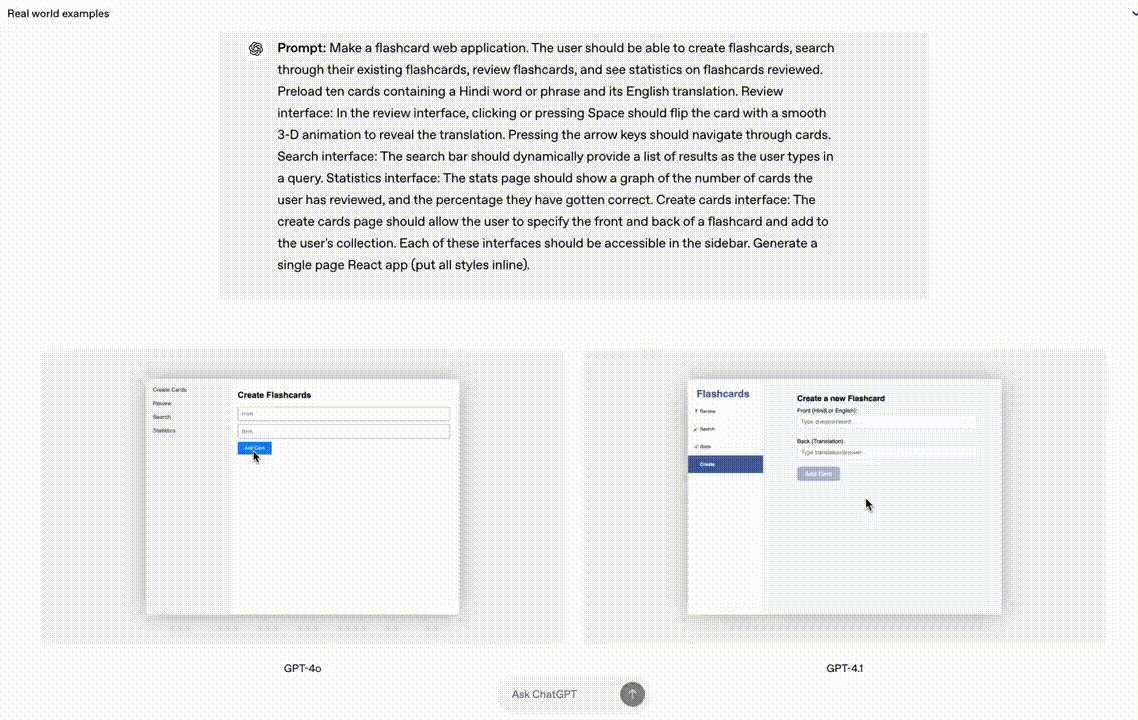
OpenAI has introduced a new family of models—GPT‑4.1, GPT‑4.1 Mini, and GPT‑4.1 Nano—built to address some of the most pressing needs in real-world LLM deployment: code reasoning, long-context understanding, and instruction alignment.
Unlike previous iterations, this release shifts focus from general-purpose capabilities to practical improvements that developers can measure and act on. Whether you're working with autonomous coding agents, building multi-step LLM workflows, or trying to parse large-scale documentation and source trees, these models bring relevant architectural gains.
The standout in the lineup, GPT‑4.1, shows measurable improvements across critical benchmarks:
Backed by a 1 million token context window and a June 2024 knowledge cutoff, this release is engineered to integrate into modern development workflows—from IDE extensions to autonomous dev tools.
One of the most compelling parts of the GPT‑4.1 release is how far OpenAI has pushed the performance envelope in smaller models. Both GPT‑4.1 Mini and GPT‑4.1 Nano are not just scaled-down versions—they’re strategically optimized for low-latency, cost-sensitive, and edge-deployable use cases that developers increasingly care about.
GPT‑4.1 Mini outperforms GPT‑4o across several intelligence benchmarks, while offering:
This makes it an ideal model for production applications that require a balance of capability and speed—think:
In terms of instruction following and long-context reliability, GPT‑4.1 Mini holds up impressively well, especially for smaller teams building serverless LLM microservices where cost is a limiting factor.
GPT‑4.1 Nano is optimized for real-time tasks and delivers standout performance for its size:
These scores surpass GPT‑4o Mini, signaling that Nano isn't just a low-end fallback—it’s a strategic choice for:
The fact that it supports a 1 million token context window at this size opens up new design space: you can now run context-heavy applications (like parsing logs or customer tickets) on a minimal inference budget.
The common thread across the GPT‑4.1 model family is improved reliability in instruction adherence and long-context reasoning—two pillars that are essential when building autonomous agents. When used with tools like OpenAI’s Responses API, developers can now ship agents that:
In short, GPT‑4.1 Mini and Nano are production-grade components that enable practical LLM applications without the traditional trade-offs between performance, latency, and cost.

GPT‑4.1 delivers a measurable leap in software engineering tasks—both in terms of semantic understanding and tool-compatible code generation. It isn't just writing syntactically correct code—it’s demonstrating agentic reasoning over entire repositories and producing production-grade outputs with precision.
On the SWE-bench Verified benchmark, GPT‑4.1 completes 54.6% of real-world issues, compared to 33.2% by GPT‑4o, marking a 21.4% absolute improvement. For context, this benchmark evaluates whether a model can:
This is a critical benchmark for AI coding assistants and autonomous agents, especially when deployed in CI/CD pipelines or integrated into developer workflows like PR automation. Even with conservative scoring (accounting for infrastructure-excluded test cases), GPT‑4.1 maintains a 52.1% accuracy, which still significantly outperforms earlier models, including GPT‑4.5.

For developers integrating LLMs into code editing tools, IDE extensions, or PR-bot style assistants, GPT‑4.1 shows notable gains:

This means GPT‑4.1 is far more reliable when applied to:
The model exhibits greater consistency in tool usage (e.g., correctly invoking custom CLI tools or formatting per project standards), and generates minimal extraneous edits, reducing noise in diffs and simplifying developer review.
Whether you’re exposing the model via API, integrating it in VS Code or JetBrains plugins, or using it in pair programming mode, GPT‑4.1's improvements translate to less prompt engineering, more deterministic results, and better alignment with dev workflows.
Its architectural upgrades seem especially optimized for:
If you're building developer tools with LLMs or deploying autonomous agents for bug fixing, GPT‑4.1 is a significant step forward in reliable, repository-aware code generation.
One of the most critical upgrades in the GPT‑4.1 model family—across GPT‑4.1, Mini, and Nano—is the ability to handle up to 1 million tokens of context, a massive jump from the 128k limit in GPT‑4o. For developers working with complex systems, this capability unlocks an entirely new class of applications that were previously limited by context truncation or aggressive summarization.
To put it into perspective: 1 million tokens is equivalent to over 8 full copies of the React codebase. This allows developers to pass:
All in a single forward pass, no windowing or external context managers required.
Beyond scale, GPT‑4.1 is trained to maintain attention across the entire input. In internal evaluations (needle retrieval tests), the model consistently identifies a small, relevant “needle” positioned anywhere within the 1M-token context—early, middle, or tail end.


This is critical for dev workflows that require:
This level of recall and salience management makes GPT‑4.1 viable not just as a summarizer or answerer, but as a first-class reasoning layer in complex agent systems.
For developers building LLM-based systems, this long-context support translates to:
Whether you're running models on multi-thousand line files, cross-referencing docs for compliance, or parsing user behavior from time-series logs, GPT‑4.1’s ability to attend across arbitrarily long input improves accuracy, reduces infra complexity, and eliminates brittle workarounds.
And for teams looking to deploy on tight latency or cost constraints, Mini and Nano maintain this same 1M-token capacity, enabling edge-compatible long-context reasoning at a fraction of the compute cost.
Lastly, here is a real-world example of GPT-4.1:


GPT‑4.1 isn’t just a routine model upgrade, it marks a major inflection point in AI-driven software development. With its enhanced reasoning, long-context reliability, and significantly improved coding benchmarks, it sets a new bar for what developers can expect from large language models.
For engineers working on complex applications, this translates to better code generation, deeper contextual understanding, and more capable AI agents that can work across entire repositories or documentation at scale.
At GoCodeo, we’re genuinely excited about these advancements. GPT‑4.1’s capabilities align perfectly with our mission to build intelligent, agentic tools that accelerate real-world software engineering. These improvements will power a new generation of developer workflows—and we’re just getting started.